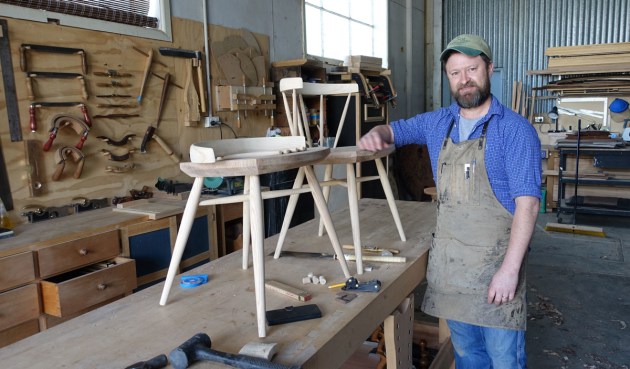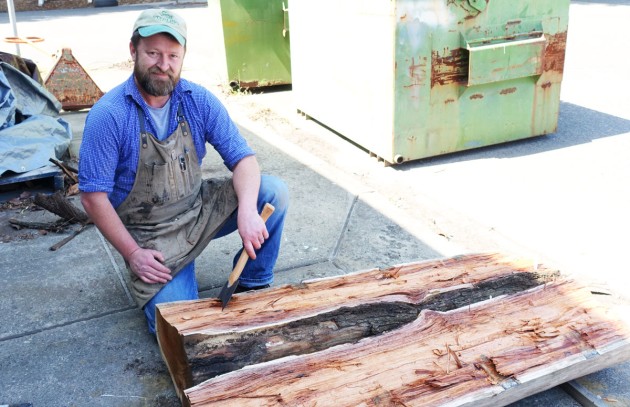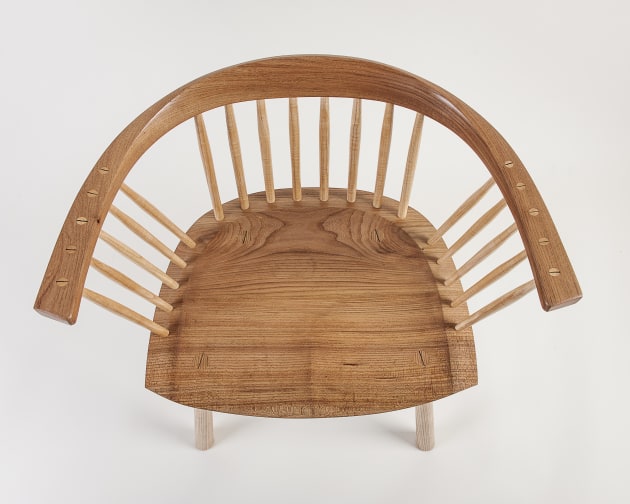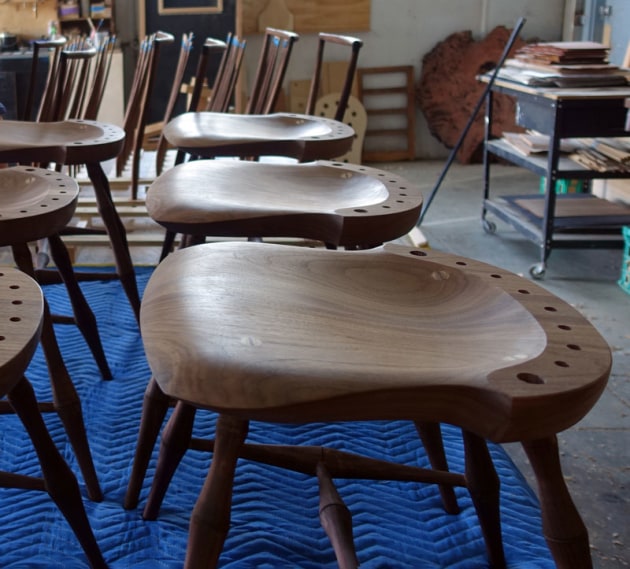Bern Chandley, modern Windsor chairmaker
Bern Chandley in an earlier workshop. Photo: Linda Nathan
Words: Linda Nathan
The technology of Windsor chairmaking represents the perfect marriage of geometry and physics as applied to the movement properties of wood. When weight is loaded onto triangulated components, it has the effect of locking them into each other.
With grain running end-to-end, thin spindles in the backs of some styles will flex in use, ironically becoming stronger, just as a tree will bend in the wind and not break. In fact only end-to-end grain is used in Windsor chair components. Spindles and crest rails are riven or bandsawn along the grain before being shaped with drawknives and spokeshaves, or turned and steambent.
Mortise and tenon constructions go right back to ancient Egypt and were used extensively in Roman times, but the Windsor style mainly evolved in England from the 1600s on. When immigrants took it to North America it evolved again, especially as techniques were adapted to different woods.
Traditional tools in everyday use for a modern maker. Photo: Linda Nathan
Bern Chandley has already clocked up a few dedades as a maker of furniture, fittings and objects of the most diverse kind. Now however, he works almost exclusively in the Windsor style, and is developing his own designs within that vernacular.
Trades ran in the family, his father and nine uncles all went that way, so when as a 16 year old he was offered an apprenticeship in carpentry and joinery it was natural he followed that tradition. There was a strange kind of apposition while learning and working as an apprentice. ‘It seemed weird to us at the time’, Bern remembers, ‘because while the curriculum taught traditional hand cut joinery we were going back (to work) and butt joining everything and banging it together with a Senko nail gun’.
In his twenties there was travel, and after that over a decade followed working on creative builds for theatre, opera, movies and TV shows. A year spent working on sets for Star Wars was pretty cool, as was watching George Lucas directing.
Chairmaking starts with source, here a blackwood log split open. Photo: Linda Nathan
Making what Bern calls ‘pretend’ furniture for theatre productions wasn’t about function, it just had to look right and be light. Even though it wasn’t built with longevity in mind, researching and simulating Art Deco, post-war and other styles of furniture was instructive. Set building contracts weren’t ongoing, so in between and afterwards, Bern was also taking on other commissions and making ‘real’ furniture.
Bern’s love for Windsor chairmaking was triggered around 12 years ago while assisting at classes given by visiting US maker and Windsor chair expert Peter Galbert at the Melbourne Guild of Fine Woodworking. ‘Peter Galbert is a really inspiring teacher’, said Bern, ‘he puts a lot into it and he’s continually trying to improve processes with better jigs and ways of doing things. I made a chair during his course and I just loved it. It was going right back to my love of joinery, where you’re creating a piece of furniture and relying on and understanding the strength of the wood to join it all together, rather than using any sort of fastener.
Looking down onto a lowback Welsh stick chair made by Bern Chandley. Photo: Christopher Sanders
‘There are 300 years old (Windsor) chairs that people are still sitting in’, Bern continued. ‘You won’t find that with other styles of chairs. Other chairs always come apart where the side rail joins the back leg because that takes so much punishment, but with Windsor chairs everything terminates in the seat and components are isolated from each other, and their geometry and joinery work together to distribute the weight of the sitter evenly.’
Bern’s favourite woods to use are mostly traditional choices such as elm for seats and ash for spindles. Oddly enough salvaged sections of elm can be easier to come by in Melbourne than back in England due to Dutch elm disease having afflicted and decimated local trees. With its often interlocked grain, elm is less likely to split in seat applications, said Bern. Ash is another traditional choice, strong and yet light for legs.
Local species that are favourites are blackwood (Acacia melanoxylon) and its paler cousin silver ash (Acacia dealbata). Both are light, bend well and are generally straight grained. Logs are split out front of the factory workshop that Bern shares with three others. Riving out components with the grain again reinforces the strength properties of components as advantage is taken of the natural inclination of the grain. An average straight- grained green log of blackwood may yield enough spindles and crest rails for a set of six chairs.
Front view of lowback Welsh stick chair. Photo: Christopher Sanders
Another boon for the woodworker, Windsor chairmaking techniques tend to produce more shavings than dust. Bern uses traditional tools such as drawknives, spokeshaves, scorps, travishers, froes, adzes, reamers and more. They may sound archaic but it’s an evolved technology of edges that can remove material efficiently at every step of the way.
Hide or animal-based glue is another traditional technology he relies on. Organic, reversible, cleans up with water – these are claims that modern adhesives can envy, and a long open time is what you need when you’re lining up and seating a whole lot of spindles and components in a glue-up.
While the designs appear ‘simple’ there is quite a lot of geometry going on with these chairs, rockers and settles. To the uninitiated, Bern’s templates look like maps of the stars with lines running off at tangents that describe angles, and small circles that mark the placement of spindles, legs and rails.

Rodback settee, Tasmanian blackwood with figured English ash spindles. Photo: Christopher Sanders
Figuring out all the angles is a science. The legs run all the way through at 6° as a through tenon. Leg mortises into the seat are first drilled and then reamed out at the same angle to create a tapered hole. Rake angles go forward and backwards while splay angles go side to side; combining the two gives the resultant angle of a leg or a spindle. It’s complex making these chairs because nothing is at 90°.
Continuous arm rocker, Melbourne street elm seat with Kyneton pin oak. Photo: Jeremy Dillon
To perform each task and know where to locate components you have to come up with reference points. Bern explained: ‘Like, how do you measure that stretcher? How do you know how to orient anything? You know you’ve got to drill that, but how do you drill it? Because nothing is at a right angle, you’ve got to come up with all these reference points. One of the most valuable things I learnt from Pete was that complexity can be overcome with well considered jigs. Once you understand the reasons behind the geometry of the chairs a whole world of design is open to you. This joinery can lend itself to incredible variations in form.’
Another continuous arm rocker. Photo: Jeremy Dillon
Most joinery involves through and wedged tenons but the duck’s bill or concealed mitre used to join the three- piece frame for a rodback chair or settee back is another example of elegant strength. After turning, components are steamed and bent. Joinery is cut before trimming tenons to length and an oak pin is run through from the top into the crest rail.
For Bern the complexity of Windsor chairmaking is stimulating and no longer concerning. With the technical side of making sorted, he is free to vary forms and create his own designs. ‘I tend to like less decorative furniture and am moving more and more away from traditional florid pieces towards simpler lines.’ In particular historical and contemporary Japanese furniture as well as mid-century Scandinavian furniture has inspired him in the way the turnings and seats of mass-produced Windsor forms were stripped back, much as the Shakers did centuries ago.
A batch of chairs in progress. Photo: Linda Nathan
Chairmaking has always represented the pinnacle of the craft of furniture design and making. No other piece of furniture requires such a close and demanding relationship with its user and its maker. While Bern also makes tables and other kinds furniture, it’s chair forms and complex joinery that captivate his interest.
Learn more about Bern Chandley @bernchandleyfurniture and the chairmaking workshops he runs via his website
Bern Chandley on the cover of Australian Wood Review, issue 90. Photo: Heather Gaskell











